

“Remix artist” Ian Woods takes the faces of the celebrities we’re so familiar with and chops and changes them by hand, making them somewhat unfamiliar, encouraging us to look closer and potentially prompting us to change the way we see them. He tells writer Alia Wilhelm how he gets his work seen, how accepting mistakes is vital to his process, and why commercial work can actually be easier than his personal passion projects.
Ian Woods describes himself as a remix artist. His collages feature athletes, actors, models and musicians. The art is layered in more ways than one, revealing as much as it conceals. Swirls of Kali Uchis’ face obscure fragments of her body. Reclaimed Stüssy ads are cut into artful loops. Lauryn Hill’s face is split in two.



“I’ve always liked pop culture,” Woods says. His mother kept People magazine in their bathroom when he was a kid, and together they would watch shows on MTV and VH1, like“Oprah”and “The Fabulous Life.”It’s important, Woods explains, that we don’t view the celebrities in his work as mere objects. Though his collages don’t comment on pop culture, they do prompt us to stop and look, then look once more. We do a double-take because the familiar has been torn up then put back together again.

Woods’ subjects tend to be modern-day celebrities, but his collages have a nostalgic feel to them. He cites the holy trinity of Warhol, Haring and Basquiat as inspiration and mainly uses analogue photos. “I like refurbished things, second-hand clothes, stuff with feeling,” he says. “It’s the same with imagery. I go after the emotion.” This is reflected in his subjects’ poses, too, which aren’t always cheery. One of his collages features a photograph of Zendaya, originally published in Vogue Italia, where the actress gazes off-screen in near biblical woe.
The emotional valence of Woods’ imagery appears to appeal to a wide Instagram audience, and most of his clients find him through social media, he says. It helps that he’s prolific, often sharing four or five new collages with his followers in one week. Currently, he’s creating artwork for a Spotify campaign, and a book cover he designed, his first ever, was recently selected by The New York Times as one of the best covers of 2022. “I find commercial work less stressful than my personal projects,” he says, since clients often pick out the source material in advance. “They know what they want. They provide the photos,” he explains.


What he now describes as his signature style is more refined than his earlier work. Back in 2015, when he was first starting out, Woods focused on objects and logos, practicing on an iPad in his spare time while he worked night-shifts as a dishwasher. Soon he was adding in swooshes of pastel, staples and stickers, then using materials like duct tape and sandpaper to distress the imagery. Even now, it’s clear his newer works are made by hand, and tangibility is part of the point. “The digital stuff loses feeling. It doesn’t feed my soul,” he says. “Physical work is authentic, raw.”
To achieve his distinctive look, Woods layers two images on top of each other. At his glass desk, a table lamp illuminates the top image, while a floor lamp shines through the bottom image from under the glass table-top. After trying out different ideas, he sketches a pattern onto the top image, so he knows what shapes to cut out with his X-Acto knife. Since the images are printer-paper-sized, carving them out with a blade is tricky, but Woods says this is what sets his work apart from others’. “People try to mimic my style on Photoshop, but it’s not the same. A lot goes into it when it’s hand-carved,” he explains. “That separates me from other people.”

Once the images have been pasted on top of each other, the work is scanned and small blemishes are removed in Photoshop, but this is as far as it goes in terms of digital correction, or any kind of editing. Woods embraces imperfection, and he is delighted when something unintended turns out well. “Most things I create do contain some type of mistake,” he says. “I go in wanting to do a specific pattern but eventually when I’m done with it, it’s not what I planned at all.” He gives the example of a collage of basketball player Allen Iverson, which ended up including less of the top image that he had planned.
“Mistakes lead me to other parts of myself, or my art, that I didn’t know existed,” Woods says, and this is the reason he sells original hard copies of his work, or “one-of-ones.” They go for $55, listed from time to time on his website. “Some people say I should charge more, but I like people having access to my art. You get to see where I messed up, which is what I love about Basquiat, too,” he says. “You never know what part of it was intended and what part of it was a mistake.”

